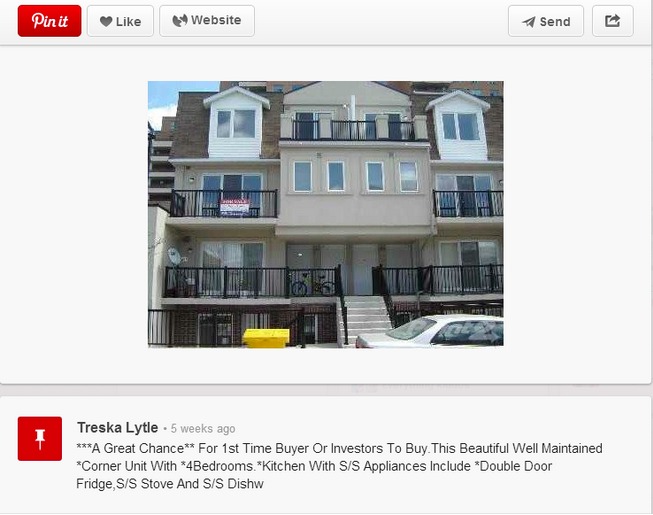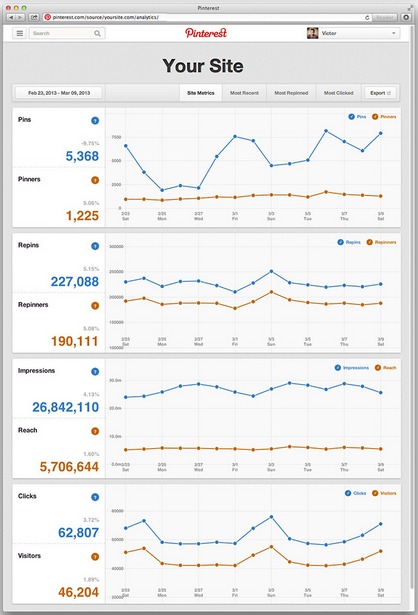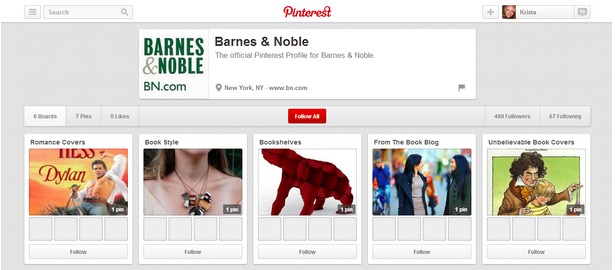Rookie meltdowns are common on Pinterest. But when you’re using it for your business’ social media marketing, those newbie mistakes can cost you.
Pinterest is an amazing social media site to visually show your brand and products, and connect with your consumers. Unfortunately, there are many brands that simply don’t get it. Everyday, I see tons of marketing mistakes being made (generally by companies who still think marketing is about pushing your products, and not about interactive engagement).
I think of Pinterest as a very personalized, interactive glossy magazine. It’s a fabulous way for users to find products they love, organize them, and share them with their friends. Pinterest users buy the products they love too. In fact, 69% of online consumers who visit Pinterest have found an item they’ve purchased or wanted to purchase (this compares to only 40% on Facebook).
As a marketer, this presents incredible opportunities. Successful brands connect with consumers on the site, and create engaging well loved posts that will are repinned to followers of followers. If you get the site right, you can have a super-charged international marketing success.
Get it wrong and, well, you’ll be a pin in a haystack. _No one is going to find you, interact with you or – buy from you. _Or, even worse, you will be called out as a marketer who doesn’t know that they are doing.
If you don’t really know what you’re doing on this fourth most popular social media site, you are bound to be making rookie mistakes. These mistakes will cost your business time, money, and, well – total embarrassment.
In this article, I outline nine of the top most common mistakes made on Pinterest – and how you can avoid them.
Most Common Pinterest Pin Mistake #1: Pinning Only your Products
Lots of traditional marketers would find this mistake counter-intuitive. On Pinterest (and really, any social media platform), pinning only about your own product or service is a big faux-pas. Social marketing is, well, social. You need to be engaging with your market, and relating to your consumer in a personable dialogue.
If you pin only about your product, and do so in a very blatant, old school push marketing method – you are going to lose followers and not get repinned.
Let’s face it, your consumers are busy people too. Many use Pinterest as a way to take a break, and to connect with friends. Pins that emotionally identify with your consumer will get repinned.
Don’t just post tons of images of your product. And especially, don’t post an image with wording like “buy this”.
Here’s an example of an old school pin from a Realtor ( real estate agents are particularly bad at social media, for reasons I don’t know):

This pin is simply a listings ad that you would find in a print newspaper. What’s the motivation for the client? How does the client become emotionally connected to this place? What’s the incentive to repin this image?
A better real estate marketing strategy would be to post a board for this listing, and include images of the interior space, as well as of the neighbourhood. Make boards with nearby schools, community facilities, and other desirable features. Sell the lifestyle, not just your product.
Most Common Pinterest Pin Mistake #2: Not Completing Your Pinterest Business Profile
Now, here’s a great rookie mistake. Be sure to make your Pinterest account a Business Account, and make sure you complete your profile.
As on Facebook, there are differences between a personal Pinterest account, and a business account. A business account will make your company look more professional and, well, credible.
Complete all the sections in the business profile, including a link to your website. Make sure you use your branded logo, so that you are easily identified on the site, even as you pin, repin and get repinned. Fill in your ‘about’ section to clearly explain who you are as a business.
It’s a fairly simple thing to do. Pinterest even lets you convert your personal site into a business one – so there’s no excuse not to have one now.
Most Common Pinterest Pin Mistake #3: Not Including $ Prices
Pinterest pins with prices get 36% more likes than pins with no prices.
This is a really easy fix. The next pin you post of your product, include the price in your description. Write it out starting the $ sign, followed by the amount in numbers. Or, if you’re more creative, you can even include the price in the image you pin.
Most Common Pinterest Pin Mistake #4: Not Pinning Engaging Content
Some of the most engaging content you can post are contests and promotions. Don’t forget to use these methods on Pinterest too (you likely already use these on Facebook and Twitter).
Use “Pin it to Win it” contests to engage with your market, and promote your products to followers of followers.
If you’re not using contests yet, you really should be. Here’s an article on 7 Tips: How to Run a Successful Pinterest Contestto give you ideas. Use Wishpond social promotions apps to make professional looking contests, with the tools you need to really succeed.
Here is a GOOD example, from Etsy, on how to engage your market with contests:

Most Common Pinterest Pin Mistake #5: Not Linking to Product Pages
I see this mistake happening all the time. Product pins that don’t link back to a product landing page miss out on an amazing marketing opportunity.
The whole point of marketing on Pinterest is to get repins. Repinning means your pin is being shared to followers, who share to their followers and so on. A Pinterest user does not have to visit your Pinterest homepage (with your about section and website) to engage with your posts. More likely, they will see your pin because it has been repinned, or it shows up in a hashtag search.
Don’t make this no-brainer mistake. Include a link to your product’s landing page on your website.
_Tip: You can even make the link trackable, using UTM codes or bit.ly’s, to measure your Pinterest results. _
Most Common Pinterest Pin Mistake #6: Not Describing Images
This mistake really irks me. If you are pinning images, don’t publish them without including a description. If you don’t include descriptions, your pins will not show up in a Pinterest search. If you are not showing up in a Pinterest search, your odds of getting repinned, or, frankly, even seen are significantly reduced.
A well written description of your product greatly increases your click throughs to your site. Any good marketer needs to know this.
Additionally, use hashtags in your description to be found by your potential customers looking for your products.
Most Common Pinterest Pin Mistake #7: Using Bad Images
Pinterest is an extremely visual site. Don’t post bad images of your products!
This should go without saying. On Pinterest, you are competing with some of the world’s best images out there! If your pins are not visually appealing, don’t post them.
Here’s an example from a very large brand, CVS Caremark, and how they do not use images that inspire and connect with their Pinterest followers:

Their images are bland and uninspiring. They give no motivation for to ‘love’ their products, or repin them. They look more like photos from a cheaply printed flyer than images that need to connect with their audience to create impact.
Don’t post bad, or poor quality images of your products. That might mean hiring a photographer, or a graphic designer with an eye for marketing. It might mean developing your own new skill. But, to be effective on Pinterest, your images need to provoke an emotional connection that will get your followers to pull your product with likes and repins.
Most Common Pinterest Pin Mistake #8: Not Using Pinterest Analytics
A big mistake by Pinterest marketers is not using the new analytics. Pinterest is giving you these free tools to make your pins and boards more effective. Use them.
Pinterest analytics lets you test and monitor your boards, pins and repins. You can get graphs that are broken down into pins, repins, impressions and clicks. You can tweak your strategies, monitor the changes, and keep improving your boards using the analytics.

Really, how can you call yourself a marketer and not love using free analytic tools? To read more, and to learn how you can better use it, check out How Sephora uses Pinterest Analytics to Create Amazing PinBoards (and you can too!).
Most Common Pinterest Pin Mistake #9: Abandoning Your Pinterest Profile
Ok, this should be very obvious, but if you do jump into a social media platform – don’t abandon it, and leave your profile page blowing in the tumbleweeds.
Now, I get why this happens. A company (maybe yours) gets excited about the latest social platform, jumps in without knowing what it’s about, tries it out, fails (because they don’t know how to engage on the site, or they don’t make the effort to maintain it), and then leaves.
What’s even more tragic, though is when that company leaves, and they don’t even deactivate their account. This leaves a ghost town – and a really bad name for the brand. This is particularly true if you’re a well known company – and you have followers on your Pinterest site.
Barnes & Noble is one of those companies.

They started a Pinterest profile, put up six boards, seven pins, and even started following 67 pinners. They now seem to have abandoned the site, leaving nearly 500 followers in the lurch. You would think a multinational company like this would know better. (They do get it better with Barnes & Noble Nook)
I would suggest if you’re making a new social site, jump in, and learn the best practices. It can take time to get it going, but you need to keep at it. It could take a few months to develop traction and followers. You really do need to make the effort everyday to build on your social sites – just as you do on Facebook and Twitter.
Try working on engaging on the site. Use different tactics. Check your analytics. If it truly isn’t working for your brand, then at least deactivate your account before you dwindle it away.
Conclusion
So, now you know how to stand out when you’re marketing on Pinterest. You do not need to become a lost pinner in the proverbial haystack, or a ghost town of a Pinterest site. To keep improving your marketing, keep using your analytics, and keep reading more about how to use Pinterest. Here are a few more resources you might like:
- [Infographic] Why Pinterest is Good for Business
- How Sephora uses Pinterest Analytics to Create Amazing PinBoards (and you can too!).
- 7 Tips: How to Run a Successful Pinterest Contest
- Pinterest Contest App
What do you think? What have you learned not to do on Pinterest? What marketing tips and words of wisdom can you share about this site?
Written by Krista Bunskoek @ Wishpond
